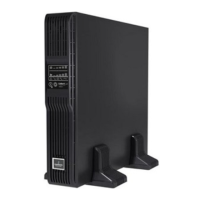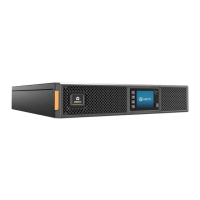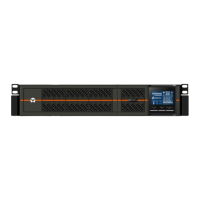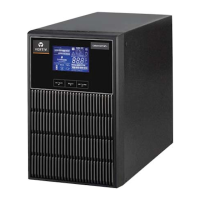Why does my Vertiv UPS beep continuously?
- JJesus WeeksJul 28, 2025
A continuous beep indicates that the Vertiv UPS has detected a fault, such as a fuse or hardware failure.
Why does my Vertiv UPS beep continuously?
A continuous beep indicates that the Vertiv UPS has detected a fault, such as a fuse or hardware failure.
Why does my Vertiv Liebert GXT5 UPS beep once every 0.5 seconds?
This beep indicates that the Vertiv UPS has detected a critical alarm, such as an inverter overload.
Why does my Vertiv UPS beep once every 1 second?
This beep indicates that the Vertiv UPS has detected a critical alarm, such as low battery voltage.
Why does my Vertiv Liebert GXT5 beep once every 3.3 seconds?
This beep indicates that the Vertiv UPS has detected a general alarm.
What to do if my Vertiv UPS fails to start?
If your Vertiv UPS fails to start, it might be due to a short circuit or overload. Turn off the UPS, disconnect all connected devices, and ensure nothing is stuck in the output receptacles. Also, verify that the connected devices are not faulty or shorted internally. Alternatively, the batteries may not be adequately charged or properly connected. Check the internal battery connection and connect it if necessary. If the battery is already connected, allow the UPS to charge for 24 hours by keeping it connected to the input power before attempting to start it again.
Why does my Vertiv UPS have reduced battery backup time?
Reduced battery backup time in your Vertiv UPS can occur for several reasons. First, ensure the UPS is plugged in continuously for at least 24 hours to fully recharge the batteries. Secondly, check the load level indicator and reduce the load on the UPS if it is overloaded. Finally, the batteries may be old and unable to hold a full charge, in which case you should replace them. Contact your Vertiv representative or Vertiv Technical Support for a replacement battery kit.
Guidelines for safely moving the UPS system during transport.
Recommendations for preparing the UPS environment before installation.
Critical safety precautions for UPS installation and connections.
Safety guidelines for operating the UPS system correctly and safely.
Safety precautions for maintenance, service, and handling UPS faults.
Technical specification for UPS output short circuit current in AC mode.
Overview of key features and available models of the Liebert GXT5 UPS.
Description of the front panel components and layout of the UPS.
Detailed illustration and description of rear panel connectors and ports.
Information on optional power distribution box (POD) options for specific models.
Details on the location and number of internal battery packs within UPS units.
Explanation of the UPS's internal components and their operational functions.
Procedure for using the manual maintenance bypass on 5-10 kVA UPS models.
Steps for unpacking the UPS and inspecting for shipping damage.
Environmental and site preparation requirements before UPS installation.
Required clearance space around the UPS for ventilation.
General guidance for installing the UPS in tower or rack configurations.
Specific instructions for installing the UPS in a tower orientation.
Instructions for installing the UPS in a rack enclosure.
Steps for connecting external battery cabinets (EBCs) to extend runtime.
Procedure for attaching the optional Power Distribution Box (POD).
Guidelines for making hardwired input and output connections.
Recommended breaker ratings and guidelines for branch circuit protection.
Specifications and procedures for making terminal block electrical connections.
Details on connecting terminal blocks for 5 and 6 kVA UPS models.
Details on connecting terminal blocks for 8 and 10 kVA UPS models.
Details on connecting terminal blocks for 16 and 20 kVA UPS models.
Overview of available UPS communication interfaces and ports.
Instructions for installing and connecting IntelliSlot communication cards.
Information on connecting to the UPS's dry contact port for alerts.
Procedure for connecting a remote emergency power off switch.
Instructions for connecting the UPS via a USB cable.
Guidance on connecting command line interface (CLI) communication cables.
Requirements and options for configuring UPS units in a parallel system.
Steps for the initial start-up and parameter synchronization of a parallel UPS system.
Procedures for commissioning a parallel UPS system after setup.
Steps for integrating an additional UPS unit into an existing parallel system.
How to silence audible alarms on the UPS unit.
Step-by-step instructions for safely starting up the UPS system.
Explanation of how the UPS transfers to battery power during outages.
Procedure for manually switching the UPS from normal to bypass mode.
Procedure for manually switching the UPS from bypass back to normal mode.
How to transfer the UPS from normal operation to standby mode.
Safe procedures for completely shutting down the UPS system.
Function and operation of the Remote Emergency Power Off (REPO) feature.
Description of the meaning of the UPS front panel LED indicators.
Overview of the LCD user interface, menus, and screens.
Information on the initial startup sequence and flow screen displays.
Navigation and options available within the UPS main menu.
How to view UPS status information through various screen tabs.
Accessing and adjusting UPS configuration and system parameters.
Options available for controlling UPS operations via the LCD screen.
Accessing and viewing current alarms and event history logs.
Information on product details, firmware versions, and efficiency.
Adjusting display and operational settings, including password protection.
Procedure for changing the default UPS system password.
How to change the language displayed on the UPS LCD screen.
Instructions for setting the UPS internal date and time.
Safety precautions and procedures for replacing UPS battery packs.
Information on battery charging and storage recommendations.
Recommended procedures for checking UPS operational status periodically.
Guidelines for safely cleaning the exterior of the UPS unit.
Procedure for replacing the UPS unit while connected to a power distribution box.
Information on where to find and how to perform firmware updates.
Common symptoms indicating a potential UPS malfunction.
Descriptions of audible alarm sounds and their meanings.
Explanation of displayed faults and their corresponding corrective steps.
Guide to identifying causes and solutions for common UPS operational problems.
Tables detailing approximate battery run times with various load and EBC configurations.
Contact information for Vertiv technical support and service.
Details for obtaining technical support and service within the USA.
Contact addresses for Vertiv headquarters in different global regions.
Legal notices regarding open source software used in the UPS product.
Guidelines for safely moving the UPS system during transport.
Recommendations for preparing the UPS environment before installation.
Critical safety precautions for UPS installation and connections.
Safety guidelines for operating the UPS system correctly and safely.
Safety precautions for maintenance, service, and handling UPS faults.
Technical specification for UPS output short circuit current in AC mode.
Overview of key features and available models of the Liebert GXT5 UPS.
Description of the front panel components and layout of the UPS.
Detailed illustration and description of rear panel connectors and ports.
Information on optional power distribution box (POD) options for specific models.
Details on the location and number of internal battery packs within UPS units.
Explanation of the UPS's internal components and their operational functions.
Procedure for using the manual maintenance bypass on 5-10 kVA UPS models.
Steps for unpacking the UPS and inspecting for shipping damage.
Environmental and site preparation requirements before UPS installation.
Required clearance space around the UPS for ventilation.
General guidance for installing the UPS in tower or rack configurations.
Specific instructions for installing the UPS in a tower orientation.
Instructions for installing the UPS in a rack enclosure.
Steps for connecting external battery cabinets (EBCs) to extend runtime.
Procedure for attaching the optional Power Distribution Box (POD).
Guidelines for making hardwired input and output connections.
Recommended breaker ratings and guidelines for branch circuit protection.
Specifications and procedures for making terminal block electrical connections.
Details on connecting terminal blocks for 5 and 6 kVA UPS models.
Details on connecting terminal blocks for 8 and 10 kVA UPS models.
Details on connecting terminal blocks for 16 and 20 kVA UPS models.
Overview of available UPS communication interfaces and ports.
Instructions for installing and connecting IntelliSlot communication cards.
Information on connecting to the UPS's dry contact port for alerts.
Procedure for connecting a remote emergency power off switch.
Instructions for connecting the UPS via a USB cable.
Guidance on connecting command line interface (CLI) communication cables.
Requirements and options for configuring UPS units in a parallel system.
Steps for the initial start-up and parameter synchronization of a parallel UPS system.
Procedures for commissioning a parallel UPS system after setup.
Steps for integrating an additional UPS unit into an existing parallel system.
How to silence audible alarms on the UPS unit.
Step-by-step instructions for safely starting up the UPS system.
Explanation of how the UPS transfers to battery power during outages.
Procedure for manually switching the UPS from normal to bypass mode.
Procedure for manually switching the UPS from bypass back to normal mode.
How to transfer the UPS from normal operation to standby mode.
Safe procedures for completely shutting down the UPS system.
Function and operation of the Remote Emergency Power Off (REPO) feature.
Description of the meaning of the UPS front panel LED indicators.
Overview of the LCD user interface, menus, and screens.
Information on the initial startup sequence and flow screen displays.
Navigation and options available within the UPS main menu.
How to view UPS status information through various screen tabs.
Accessing and adjusting UPS configuration and system parameters.
Options available for controlling UPS operations via the LCD screen.
Accessing and viewing current alarms and event history logs.
Information on product details, firmware versions, and efficiency.
Adjusting display and operational settings, including password protection.
Procedure for changing the default UPS system password.
How to change the language displayed on the UPS LCD screen.
Instructions for setting the UPS internal date and time.
Safety precautions and procedures for replacing UPS battery packs.
Information on battery charging and storage recommendations.
Recommended procedures for checking UPS operational status periodically.
Guidelines for safely cleaning the exterior of the UPS unit.
Procedure for replacing the UPS unit while connected to a power distribution box.
Information on where to find and how to perform firmware updates.
Common symptoms indicating a potential UPS malfunction.
Descriptions of audible alarm sounds and their meanings.
Explanation of displayed faults and their corresponding corrective steps.
Guide to identifying causes and solutions for common UPS operational problems.
Tables detailing approximate battery run times with various load and EBC configurations.
Contact information for Vertiv technical support and service.
Details for obtaining technical support and service within the USA.
Contact addresses for Vertiv headquarters in different global regions.
Legal notices regarding open source software used in the UPS product.
| Output Voltage | 200/208/220/230/240 VAC |
|---|---|
| Topology | Double Conversion Online |
| Input Voltage | 200/208/220/230/240 VAC |
| Output Frequency | 50/60 Hz |
| Display | LCD |
| Operating Temperature | 0 to 40°C (32 to 104°F) |
| Dimensions | Varies by model |
| Weight | Varies by model |
| Form Factor | Rack/Tower |
| Power Capacity | 1-20 kVA |
| Communication Ports | USB, RS-232 |
| Waveform Type | Sinewave |
| Input Frequency | 50/60 Hz |
| Power Factor | 0.9 |
| Operating Humidity | 0-95% non-condensing |
| Battery Type | Valve-regulated lead acid (VRLA) |











